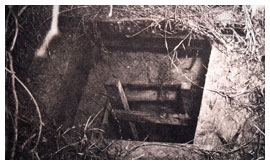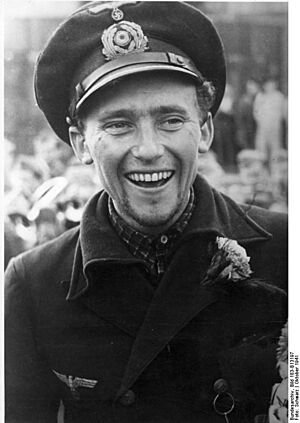Great Papago Escape facts for kids

The entrance to the tunnel was concealed by a large box of coal.
|
|
| Date | December 23, 1944 – January 28, 1945 |
|---|---|
| Location | Camp Papago Park, Arizona, United States |
| Participants | Jürgen Wattenberg Hans-Werner Kraus Friedrich Guggenberger August Maus |
The Great Papago Escape was the biggest escape by German prisoners of war from an American camp during World War II. On December 23, 1944, twenty-five Germans dug a tunnel out of Camp Papago Park. This camp was near Phoenix, Arizona. They then ran into the desert around the camp.
Over the next few weeks, all the escapees were caught again. No one was hurt during these recaptures. Most were found in Maricopa County. A few almost reached the border of Mexico, which was about 130 miles away.
Contents
What Was Camp Papago Park?
Camp Papago Park was built in 1943. It was located in Papago Park, a public park in eastern Phoenix. At first, the camp was meant for Italian prisoners. But by January 1944, it held only German prisoners. Most of these prisoners were from the German navy, called the Kriegsmarine.
The camp had five separate areas. One area was for officers, and the others were for regular soldiers. At its busiest, the camp held about 3,100 prisoners. There were also 371 American guards and officers.
Camp Papago Park looked like a typical prison camp. It had barbed wire fences and watchtowers. But it was unusual because prisoners did not have to work or study. To fight boredom, many Germans volunteered for jobs. They worked as laborers in nearby cotton fields and other places.
The Escape Plan
Many men in the officers' area were U-boat sailors. This included their leader, Captain Jürgen Wattenberg. He was the highest-ranking German prisoner at the camp. Captain Wattenberg had fought in the Battle of the River Plate. He also commanded the U-boat U-162. This U-boat was sunk near Trinidad by the Royal Navy in September 1942. After that, the British handed Wattenberg and his crew over to the Americans.
According to author Cecil Owen, Wattenberg was known for causing trouble. He was moved from camp to camp. Finally, he was sent to Papago Park. The American commander made a mistake. He put all the most difficult and escape-prone prisoners together. They were all in the officers' area. Only Captain Cecil Parshall, the camp's police chief, saw a problem with this.
Parshall pointed out a spot in the officers' area. This spot could not be seen from the guard towers. It was perfect for an escape. He knew the smart German prisoners would find it.
Wattenberg started planning an escape as soon as he arrived. He chose the blind spot for the tunnel's entrance. This spot was next to a bathhouse. The bathhouse was the building closest to the camp's eastern edge. Wattenberg had his men start the tunnel from inside the building. When Germans went to shower, they could easily enter the tunnel to dig.
To hide the tunnel entrance, they removed part of a wooden wall. Then they placed a large box of coal in front of it. Wattenberg asked the Americans for tools like shovels. He said they needed them for gardens and a volleyball field. But he really wanted them for the tunnel. Arizona's soil is rocky, so the Americans did not expect them to dig a tunnel. They gave the prisoners two shovels and two rakes. These tools had to be returned every day.
Building the Tunnel
Work on the tunnel began in September 1944. Three groups of three men worked on it. They worked for ninety minutes each night. One man dug with a pick and shovel. The second gathered dirt in a bucket. The third pulled the dirt out and watched for guards. A fourth group got rid of the dirt.
At first, the Germans flushed dirt down toilets. They also hid it in attics. Sometimes they dropped it down their pant legs into gardens. But as the tunnel grew longer, they spread the dirt on the volleyball field. The Americans never noticed the disturbed dirt. The volleyball field was under construction. So, guards were used to seeing piles of dirt and thought nothing of it.
The Germans finished their tunnel on December 20. It was 178 feet (54 meters) long. It went from the bathhouse east to the Cross Cut Canal. It had a six-foot (1.8 meter) deep entrance shaft. Wattenberg also got new clothes and fake papers for his men. These papers included contacts in Mexico who could help them return to Germany.
He saved food for the escape. He also arranged for other prisoners to celebrate loudly on December 23. This was to create a distraction.
Setting the Date
Wattenberg wanted to get far away before guards noticed they were gone. To buy time, four U-boat captains told the Americans they would not attend roll call. They said they would only appear if an officer conducted it. The American commander did not agree. He put the entire area on a limited diet for every day the officers refused.
The roll call strike lasted sixteen days. It ended with a compromise. All men, no matter their rank, would be at roll call. This would happen every morning except Sunday at 9:00 AM. It would also happen every afternoon at 4:15 PM. Officers above the rank of lieutenant captain could stand in their barracks doorways to be counted. The Germans got what they wanted. So, the escape date was set for Saturday, December 23, 1944.
The Great Escape Night
The escape began at 9:00 PM on December 23. By 2:30 AM on December 24, Wattenberg and twenty-four other men had gone through the tunnel. The guards did not notice anything. Inside the Cross Cut Canal, the Germans went south. They headed towards the Salt River.
Captain Wilhelm Günther and Lieutenants Wolfgang Clarus and Friedrich Utzolino built a raft. It was made from wood and rubber scraps. They hoped to float down the Salt River, to the Gila River, to the Colorado River, and into the Gulf of California. But they found very little water in the Salt River. They left the raft after a short time. The other escapees split into pairs and small groups. They went different ways, avoiding trains and buses.
The Manhunt Begins
It was not until about 7:00 PM on December 24 that Captain Parshall knew prisoners were missing. Soon after, hundreds of soldiers, FBI agents, and Papago Indian scouts were called in. The Phoenix Gazette called it "the greatest manhunt in Arizona history."
Most escapees were caught because they were hungry. The weather was cold and rainy. They also did not know the area. Many gave up within the first few days. But a few others lasted much longer. On January 1, 1945, two prisoners were caught by Papago scouts. They were less than thirty miles from the Mexican border. Soon after, Captain Lieutenants Friedrich Guggenberger and Jürgen Quaet-Faslem were caught within ten miles.
Günther, Clarus, and Utzolino were caught on January 8. Utzolino decided a canal near Gila Bend would be a good place to wash his underwear. Some cowboys saw the group at the canal. They told the military, and the men were caught.
The Last One Caught
The last escapee to be caught was Captain Wattenberg. He was captured over a month after the escape, on January 28, 1945. Instead of heading south, Wattenberg and two of his men, Walter Kozur and Johann Kremer, hid in a cave. This cave was in the mountains north of Phoenix. From there, they explored the area. They even dared to go into the city.
According to author Ronald H. Bailey, Kremer did something very unusual. Every few days, he would meet a German worker sent outside the camp. He would then switch places with him. The exchanged prisoner would spend the night in the cave with Captain Wattenberg. Kremer would slip back into camp. Inside, Kremer would gather food and information. To deliver the food, he would either join a work group and escape again, or send it out with another worker.
This continued until January 22. A surprise inspection showed Kremer was in camp. Kremer must have given information to his captors. The next night, Kozur was caught by three soldiers. He was at the abandoned car used to hide supplies. Four days later, on January 27, 1945, Wattenberg cleaned up. He then hiked into Phoenix. He had 75 cents. He spent most of it on a meal at a restaurant. He slept in a chair in a hotel lobby for a few hours. Then he walked around the streets at night. While walking, he asked a street cleaner for directions. The cleaner found Wattenberg's accent suspicious. He called the police. Wattenberg was arrested by 9 AM the next morning.
What Happened After
Some of the escapees expected harsh punishment. They knew that 50 Allied prisoners had been executed after escaping from a German camp (this was known as the Great Escape). But the Camp Papago Park escapees were only given bread and water. They received this for the same number of days they were absent from camp.
None of the American guards were seriously punished. But the FBI started an investigation. They looked into the relaxed security at Arizona's prisoner of war camps.
Today, part of the Camp Papago Park site is an Arizona National Guard base. The Arizona Military Museum is on the base. It has a display describing the camp and the story of the escape.



